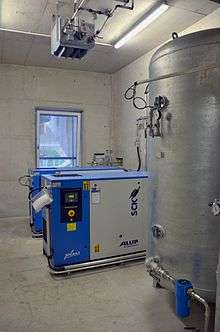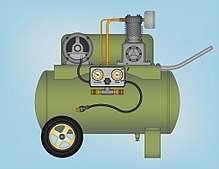Compressed air
Compressed air is air kept under a pressure that is greater than atmospheric pressure. Compressed air is an important medium for transfer of energy in industrial processes. Compressed air is used for power tools such as air hammers, drills, wrenches and others. Compressed air is used to atomize paint, to operate air cylinders for automation, and can also be used to propel vehicles. Brakes applied by compressed air made large railway trains safer and more efficient to operate. Compressed air brakes are also found on large highway vehicles.
Compressed air is used as a breathing gas by underwater divers. It may be carried by the diver in a high pressure diving cylinder, or supplied from the surface at lower pressure through an air line or diver's umbilical. Similar arrangements are used in breathing apparatus used by firefighters, mine rescue workers and industrial workers in hazardous atmospheres.
In Europe, 10 percent of all industrial electricity consumption is to produce compressed air—amounting to 80 terawatt hours consumption per year.[2][3]
History
Industrial use of piped compressed air for power transmission was developed in the mid 19th century; unlike steam, compressed air could be piped for long distances without losing pressure due to condensation. An early major application of compressed air was in the drilling of the Mont Cenis Tunnel in Switzerland in 1861, where a 600 kPa (87 psi) compressed air plant provided power to pneumatic drills, increasing productivity greatly over previous manual drilling methods. Compressed air drills were applied at mines in the United States in the 1870s. George Westinghouse invented air brakes for trains starting in 1869; these brakes considerably improved the safety of rail operations.[4] In the 19th century, Paris had a system of pipes installed for municipal distribution of compressed air to power machines and to operate generators for lighting. Early air compressors were steam-driven, but in certain locations a trompe could directly obtain compressed air from the force of falling water.[5]
Breathing
Air for breathing may be stored at high pressure and gradually released when needed, as in scuba diving. Air for breathing must be free of oil and other contaminants; carbon monoxide, for example, in trace amounts that might not be dangerous at normal atmospheric pressure may have deadly effects when breathing pressurized air. Air compressors and supply systems intended for breathing air are not generally also used for pneumatic tools or other purposes.
Workers constructing the foundations of bridges or other structures may be working in a pressurized enclosure called a caisson, where water is prevented from entering the open bottom of the enclosure by filling it with air under pressure. It was known as early as the 17th century that workers in diving bells experienced shortness of breath and risked asphyxia, relieved by the release of fresh air into the bell. Such workers also experienced pain and other symptoms when returning to the surface, as the pressure was relieved. Denis Papin suggested in 1691 that the working time in a diving bell could be extended if fresh air from the surface was continually forced under pressure into the bell. By the 19th century, caissons were regularly used in civil construction, but workers experienced serious, sometimes fatal, symptoms on returning to the surface, a syndrome called caisson disease or decompression sickness. Many workers were killed by the disease on projects such as the Brooklyn Bridge and the Eads Bridge and it was not until the 1890s that it was understood that workers had to decompress slowly, to prevent the formation of dangerous bubbles in tissues.[6]
Air under moderately high pressure, such as is used when diving below about 20 metres (70 ft), has an increasing narcotic effect on the nervous system. Nitrogen narcosis is a hazard when diving. For diving much beyond 30 metres (100 ft), it is less safe to use air alone and special breathing mixes containing helium are often used.
Uses of compressed air

In industry, compressed air is so widely used that it is often regarded as the fourth utility, after electricity, natural gas and water. However, compressed air is more expensive than the other three utilities when evaluated on a per unit energy delivered basis.[7]

_type_refrigerated_compressed_air_dryer.jpg)
Compressed air is used for many purposes, including:
- Pneumatics, the use of pressurized gases to do work
- Pneumatic post, using capsules to move paper and small goods through tubes.
- Air tools
- HVAC control systems
- Vehicle propulsion (see compressed air vehicle)
- Energy storage (see compressed air energy storage)
- Air brakes, including:
- railway braking systems
- road vehicle braking systems
- Underwater diving, for breathing and to inflate buoyancy devices
- Refrigeration using a vortex tube
- Air-start systems in engines
- Ammunition propulsion in:
- Air guns
- Airsoft equipment
- Paintball equipment
- Cleaning dust and small debris in tiny spaces
- Sandblasting in machine shops
- Injection molding
- Food and beverage capping and fermentation[8]
- Compressed air from Lysefjorden/Preikestolen (Norway) is being sold in cans, mostly to China.[9]
Design of systems
Compressor rooms must be designed with ventilation systems to remove waste heat produced by the compressors.[10]
Water and Oil Vapor Removal
When air at atmospheric pressure is compressed, it contains much more water vapor than the high-pressure air can hold. Relative humidity is governed by the properties of water and is not affected by air pressure.[11] After compressed air cools, then the vaporized water turns to liquefied water.[12], [13]
Cooling the air as it leaves the compressor will take most of the moisture out before it gets into the piping. Aftercooler, storage tanks, etc. can help the compressed air cool to 104°F, then 2/3 of water turns to liquid.[14]
Management of the excessive moisture is a requirement of a compressed air distribution system. System designers must ensure that piping maintains a slope, to prevent accumulation of moisture in low parts of the piping system. Drain valves may be installed at multiple points of a large system to allow trapped water to be blown out. Taps from piping headers may be arranged at the tops of pipes, so that moisture is not carried over into piping branches feeding equipment. [15] Piping sizes are selected to avoid excessive energy loss in the piping system due to excess velocity in straight pipes at times of peak demand,[16] or due to turbulence at pipe fittings. [17]
Sharp Angles
Use 45-degree lateral fitting in lieu of 90-degree tee fitting. Compressed Air should enter the run connection of lateral pipe fittings, never to the branch connection of tees.[18],[19],[20]
A 90-degree elbow bend causes can often amount to 3 to 5 PSID of pressure loss thru turbulence. Prefer to install a series of 30- to 45-degree bends instead of 90-degrees elbows, or at least long radius 90-degree elbows.[21]
Multiple Air Compressors
Arrange the discharge pipes from multiple air compressors to connect via 45-degree lateral connections into the top of the header piping so water from the first compressor does not drain to a downstream compressor that is OFF. Compressed air piping should be slope downward in the direction of the compressed air flow, usually 1 inch per 10 feet of pipe. Provide a low point drain to remove water via an automatic drain trap at the drip legs.[22]
See also
- Air compressor
- Air dryer
- Cabin pressurization
- Compressed air dryer
- Gas compressor
- Gas dusters generally use fluorocarbons but some use compressed air.
- Rotary-screw compressor
Notes
| Wikimedia Commons has media related to Compressed air. |
- Leino, Raili (24 February 2009). "Paineilma hukkaa 15 hiilivoimalan tuotannon" (in Finnish). Archived from the original on 17 July 2011. Retrieved 24 February 2009.
- "Compressed Air System Audits and Benchmarking Results from the German Compressed Air Campaign "Druckluft effizient"" (PDF). Archived from the original (PDF) on 2011-12-24.
- Lance Day, Ian McNeil (ed.), Biographical Dictionary of the History of Technology, Routledge, 2002, ISBN 1134650205,p. 1294
- Peter Darling (ed.), SME Mining Engineering Handbook, Third Edition Society for Mining, Metallurgy, and Exploration (U.S.) 2011, ISBN 0873352645,p. 705
- E. Hugh Snell, Compressed Air Illness Or So-called Caisson Disease H. K. Lewis, 1896 pp.
- Yuan, C., Zhang, T., Rangarajan, A., Dornfeld, D., Ziemba, B., and Whitbeck, R. “A Decision-based Analysis of Compressed Air Usage Patterns in Automotive Manufacturing”, Journal of Manufacturing Systems, 25 (4), 2006, pp.293-300
- "Applications - Working With Compressed Air - CAGI - Compressed Air And Gas Institute". www.cagi.org. Archived from the original on 2017-01-28. Retrieved 2017-01-12.
- "Selger frisk luft fra Preikestolen på eBay". Stavanger Aftenblad (in Norwegian). Archived from the original on 18 August 2016. Retrieved 15 August 2016.
- "Some Like It Hot…Your Compressor Room Doesn't". Compressed Air Tips from Kaeser Talks Shop. 5 May 2015. Archived from the original on 13 January 2017. Retrieved 2017-01-12.
- Fluid-Aire Dynamics, Inc. | Relative Humidity vs. Dew Point in Compressed Air Systems
- Quincy Compressor
- Atlas Copco | How can water harm my compressed air system?
- Quincy Compressors | All About Compressed Air Piping Systems
- COMPRESSOR INLET PIPING by Hank van Ormer, Air Power USA, Compressed Air Best Practices, 06/2012 Page 26, column 2, Note 12. Archived 2015-09-10 at the Wayback Machine
- "Plant services (2005 - 2006 Collection) "Eliminate Mr. Tee"". p. 5. Archived from the original on 2013-11-24.
- Merritt, Rich (May 2005). "Top 10 Targets of a Compressed Air Audit" (PDF). Plant Services magazine. p. 31. Archived from the original (PDF) on 2016-12-21.
- USF United States Fittings |lateral pipe fittings
- Air Best Practices
- UCSF Medical Center Design Guidelines | Section 23 - HVAC | Page 70 of 125
- Quincy Compressors | All About Compressed Air Piping Systems
- Continuing Education and Development, Inc.